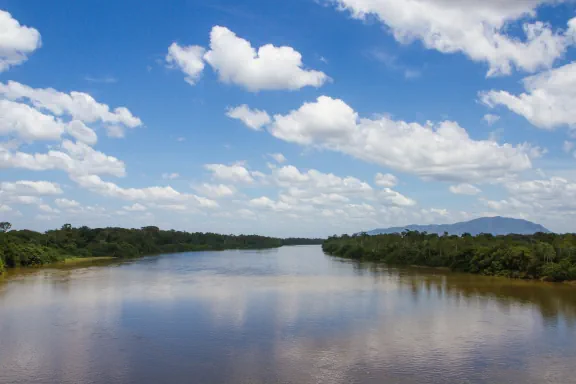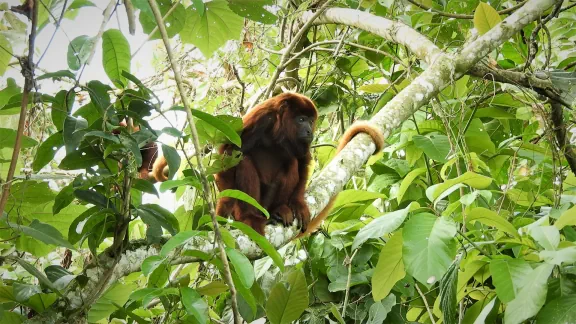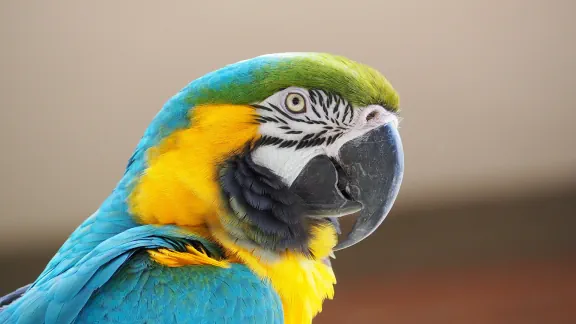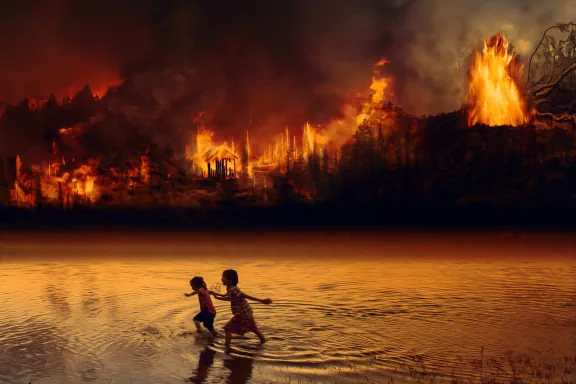
The Amazon: A carbon sink in decline

Table of Contents
New research suggests that the amazon is now a net producer of greenhouse gasses. This is something scientists have warned of for decades, but how have we reached this point? Here we’ll dive into an explanation of why the Amazon is so important, how it works as a carbon sink and why it’s not functioning as one anymore.

River in the Amazon Pixabay
Why is the Amazon important
Along with being the largest area of tropical forest in the world, it also creates its own weather patterns, contains a huge amount of biodiversity, and plays a key role in the global cycling of greenhouse gasses (GHGs).
A centre for biodiversity
10% of the world’s biodiversity is stored within this vast expanse of rainforest. There are 1300 species of birds, compared to just 530 species in the whole of Europe. There are 450 reptile species, 472 mammal species, and trees that grow 200 feet tall and 10 feet wide. There’s a huge diversity of people too, with 350 ethnic groups native to the region, including uncontacted communities.

A howler monkey, one of nature’s loudest animals. Pixabay
Water for the world
The Amazon river is huge at 4000 miles long, second only to the Nile, with over a thousand tributaries. Water from this river makes up 17% of all freshwater entering oceans globally, influencing both sea levels and salinity.
It’s also key for the water cycle. “Evapotranspiration” is the process of water evaporating both from plants and the earth’s surface. Trees suck water up from the soil which is then released via their leaves as water vapour. Via this process Amazonian flora release vast quantities of water which drives rainfall. Essentially, the Amazon rainforest creates its own rain.
A key carbon sink
For millennia, the Amazon acted as a significant carbon sink. This means that it takes in more carbon than it releases. Photosynthesis is the process that makes this happen. Trees take in carbon dioxide, water, and sunlight to produce glucose (sugar), oxygen, and water. This glucose is then used to produced bark, wood, stems, and everything else. The average Amazonian tree is 40% carbon in composition, which is stored until the tree dies.
There are 3 times more trees in the Amazon than there are stars in the Milky Way, and each of them is photosynthesizing whenever the sun is out. And it’s not just trees, it’s everything that grows. The result is that the Amazon contains the equivalent of 10 years of fossil fuel emissions

A blue and yellow macaw, commonly seen in the Amazon. Pixabay
It’s not all about carbon
The new research highlights that while carbon dioxide is important, there are other GHGs that need to be accounted for.
GHGs keep the heat from the sun trapped within the earth’s atmosphere. These gasses exist naturally, but via human activity, their concentrations are increasing within the atmosphere. This, in essence, is climate change.
Carbon dioxide is the one most talked about. However, the study highlights other key GHGs:
- Methane
- Nitrous oxide
- Biogenic volatile organic compounds (BVOCs)
- Ozone
- Aerosols
- Black Carbon Aerosols
The majority are gasses that naturally exist in small quantities. For instance, methane is produced via decomposition within soils, releasing it into the atmosphere. Trees also release methane which they have absorbed via their roots. Simultaneously, specific bacteria in soils are capable of breaking down methane, removing it from the atmosphere. This is a good example of how GHGs flow naturally within ecosystems. The Amazon’s trees naturally contribute 3.5% of methane emissions globally.
The other GHGs also occur naturally, such as nitrous oxide which is also produced via natural processes in soils. BVOCs are a product of plant growth and communication. Aerosols are produced by plants and during chemical processes in the air above the Amazon, while black carbon aerosols are a product of burning.
An unbalanced system
GHGs in and of themselves are not inherently bad. Without human intervention, they cycle naturally around the globe. The danger comes when we artificially alter the natural balance. There is a complex fine tuning to these systems which when altered produces consequences as complex as the system itself.
Human intervention is driving increasing quantities of these GHGs to be released from the Amazon. Methane production is augmented via agriculture, while dams alter river functions resulting in increased levels of both nitrous oxide and methane. Nitrous oxide acts to trap heat in the same way that carbon dioxide does, except that it is more than 300 times more potent at trapping heat. For methane, it is 28 times worse than carbon dioxide.
A Carbon sink in Decline
At the same time that these other GHGs are being un-naturally altered, the Amazon is losing its capacity as a carbon sink. As of 2015, the carbon uptake per hectare was half of what it was 20 years ago. One million square km have been lost in the Amazon since 1978.
This leads to the question: how has this happened?
The answer to this question is as complicated as the region itself. The Amazon spans across 8 countries: Brazil, Peru, Colombia, Bolivia, Ecuador, Venezuela, Guyana, and Suriname. The politics and history of each country influence what happens in their respective sections in the Amazon. However, there are unifying factors across the region.
A forest on fire
Fires were all over the news in 2019, but they arrive every year with the start of the dry season. The Brazilian Amazon is number one in the world for fire-driven deforestation. These fires are often set intentionally by farmers clearing agriculture but are also brought about by drought. As climate change brings the likelihood of increased drought, the frequency of fires is likely to increase.
Burning rapidly releases the carbon dioxide stored in trees, but also releases other GHGs such as biogenic volatile organic compounds (BVOCs) and black carbon aerosols. As well, fires cause degradation leading to trees slowly dying over time, resulting in carbon dioxide being continually released over several years.

A forest fire in the Amazon. Pixabay
Cattle take over
Agriculture drives land clearance for the production of commodities sold both locally and internationally.
There are 7 main commodities driving deforestation:
- Cattle
- Oil palm
- Soy
- Cocao
- Rubber
- Coffee
- Wood fibre
Globally, the expansion of these commodities was responsible for 57% of deforestation caused by agriculture between 2001 and 2015. In the Brazilian Amazon specifically, clearing for cattle accounted for as much as half of all deforestation. Cattle are particularly bad as they produce methane, so productive forest is converted into a net GHG producer.
The gold rush
Tiny specs of gold exist in the soils of the Amazon, meaning that to retrieve it you have to clear everything. The land is clear cut and water is pumped in to sift the soil, leaving a muddy expanse where forest once stood. Mercury is burnt to retrieve the gold, poisoning rivers. At the same time, towns grow around mining areas, bringing infrastructure, hunting, and fires.
While some gold mining is legal, illegal mining is also significant. An estimated 10% of total amazon loss was driven by illegal gold mining between 2005 and 2015.
Hydropower
While hydropower may produce “clean” energy, the environmental impact of dams and reservoirs likely outweighs the costs.
All 4000 miles of the Amazon River and its tributaries represent a complex ecosystem. Alterations to this system separate species, prevents movement, and reduces water quality, to name just a few of the impacts. It also affects the flow of sediments and nutrients in the river, altering the movements of GHGs. Research shows that the net impact for the climate of dams offset the benefits of hydropower for several years after.
Hunting and Overfishing
Walking around markets in Amazonian towns you are likely to find evidence of hunting. While communities have hunted traditionally for millennia, the increasing demand has driven hunting to unsustainable levels.
There are clear impacts on biodiversity, but there are knock-on effects too. Removal of certain species impacts the ecological functioning of the forest. For example, large mammals eat certain fruit, the seeds of which are then ‘planted’ elsewhere. The loss of these animals changes the composition of the forest and reduces carbon intake and storage.
The tipping point?
There is a positive feedback loop that is driving the Amazon towards becoming a savannah. The rainforest creates its own rain, so the loss of trees means less rain which means less growth. At the same time, climate change is likely leading to more droughts. This cycle continues in an ever shortening loop until amazon becomes a dry, open savannah. This is what’s referred to as the tipping point.
So, what does it all mean?
There is extensive research examining the impacts of all of the above drivers of forest loss on carbon emissions, but less so on the multiple other GHGs. What this study, carried out by 31 scientists and funded in part by National Geographic, offers us is an examination of these previously unconsidered GHGs in comparison with current data on carbon dioxide. Their findings suggest that the Amazon is now estimated to do more damage than good for the climate.
It’s important to emphasise that this is not the natural state of affairs, this current situation is primarily due to improper treatment in this delicate ecosystem.
It’s also not saying we should give up hope. With action, this can be undone and the Amazon can continue its vital role in regulating the earth’s climate. There are glimmers of hope in the Amazon, such as a 78% decrease in gold mining in the Peruvian Amazon, along with a decrease in deforestation driven by soy agriculture thanks to a public-private initiative. The findings of this new research should spur us on to continue fighting for the world’s largest patch of tropical forest, rather the wave a white flag.